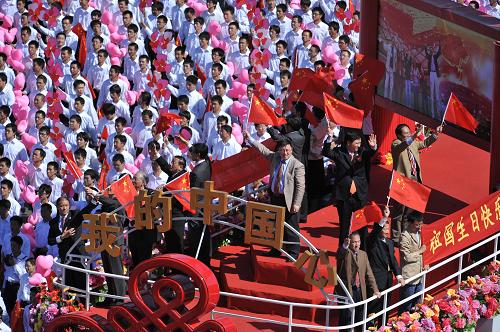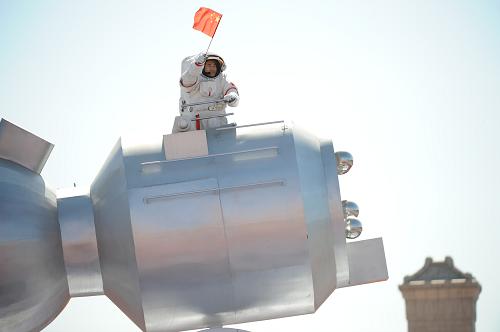Civilian pageant highlights China's rise
Civilian formations marched in Tian'anmen Square as another centerpiece of the National Day fete marking the 60th birthday of the People's Republic of China.
Leading the mass pageant was the formation presenting the national flag and national emblem. A total of 1,949 young men held up and escorted the flag, the largest-yet displayed during China's national day parades in Tian'anmen. The flag weighs about 150 kilograms and covers nearly 600 square meters, bigger than a basketball court.
|
|
In succession, four giant portraits of late Chinese leader Chairman Mao Zedong, chief architect of China's economic reform Deng Xiaoping, former President Jiang Zemin and incumbent Hu Jintao, were carried through the square escorted by some 36,000 paraders.
Their voice recorded at significant historical moments, from Mao's proclamation of the founding of the central government to Hu's calling for the building of a comprehensive well-off society, was replayed during the procession, illustrating their outstanding leadership and wisdom.
The portraits were accompanied by floats featuring different themes, including "self-reliance" for the Mao period, "reform and opening-up" for Deng's era, Jiang's "three represents" and Hu's "scientific development".
 |
China's early leaders, especially Mao, are still well remembered by the public. A new portrait of Mao replaced an old one hanging over the gate of the Tian'anmen Rostrum before the National Day.
On the opposite of the square was a newly erected portrait of Dr. Sun Yat-sen, a forerunner of the Chinese democratic revolution. The two great men fixed their eyes upon the joyful crowds and the once-in-a-decade celebration.
Deng was most renowned for masterminding the reform and opening-up drive, which saved China from an economic breakdown after the chaotic 10-year Cultural Revolution (1966-1976) and ushered an amazing economic development that earned respect from the world.
|
|
|
Jumbo jet, high-speed train show 'China drive' at National Day parade |
In Jiang's period, he proposed the important thought of "three represents", requiring the Communist Party of China to always represent the development requirements of China's advanced social productive forces, the progressive course of China's advanced culture and the fundamental interests of the overwhelming majority of the Chinese people.
While the portrait of Hu Jintao filed past the center of the square, Hu's remark -- "work hard to achieve new victories in building a moderately prosperous society in all respects and write a new chapter of a happy life for the people" -- was broadcast, depicting a bright prospect for Chinese.
The remark was delivered at the CPC's 17th National Congress on Oct. 15, 2007, which endorsed the doctrine of Scientific Outlook on Development in the CPC's Constitution and unveiled the Party's determination to promote more coordinated development on the basis of social harmony, environmental protection and energy conservation in addition to economic expansion.
 |
Following the portrait phalanxes, or the first chapter of the civilian pageant, were 43,000 people from all walks of life and 19 floats, featuring China's achievements ranging from agriculture, industry to democracy, space program, education, science and sports.
Earth-shaking changes have taken place, especially since China implemented the reform and opening-up drive.
The agriculture formation reflected China's highly improved grain production capacity that feeds the 1.3 billion population. China has become the world's top producers of various kinds of farm products, with grain output hitting 528 million tonnes and poultry production topping 72.80 million tonnes in 2008.
The industry formation reminded people of how the moribund industrial sector survived the disastrous Cultural Revolution era and transformed into a powerful production force, that finally turned China in to the world's workshop. The county, which had to import even a box of match 60 years ago, is exporting goods from lighters to satellites to more than 200 countries in the world.
 |
Trailing after were formations featuring China's pursuit of clean energy and increasing efforts in environmental protection. Floats carrying sculptures of trains, airplanes and automobiles revealed the country's expanding traffic infrastructure and increasing demand for renewable energy to prevent severe environmental degradation.
Paraders dressed in dark blue working uniforms along with a float carrying a domestically-built rocket and a huge terrestrial globe was in the formation illustrating China's ambitious space program.
China's first space walker Zhai Zhigang showed up on a float along with four other colleagues who have entered space aboard Shenzhou series of spaceships.
Students from various universities, sports stars including famous hurdler Liu Xiang, legendary gymnast Li Ning and gold medalists of the 2008 Beijing Olympics, were among some other formations, showcasing the achievements in education and sports.
|
|
|
Spacewalker revives moment of glory at National Day celebrations |
The procession also recalled people's sadness about the devastating floods in 1998 and the 8-magnitude earthquake that mainly hit Sichuan Province last year, but also highlighted Chinese people's indomitable spirit in overcoming difficulties.
A total of 8,500 paraders and 34 floats then filed along Chang'an Avenue, featuring the accomplishments and unique character of 31 mainland regions and Hong Kong, Macao and Taiwan.
The Taiwan float, carrying some sculptures of landmark constructions and two miniature airplanes flying from each side of a rainbow, highlighted the improved cross-Strait relations between the Chinese mainland and the island, which began direct air and sea transport links and postal services at the end of last year.
In the final part of the civilian pageant, the Chapter of the Future, thousands of children and Young Pioneers and a simulated boat passed the Tian'anmen Rostrum, conveying the message that children are the future of the country and will carry on the cause of socialism with Chinese characteristics.
With 60,000 doves of peace and numerous colored balloons released into the sky, the children paraders surged toward the Golden Water Bridge at the north of Tian'anmen Square, bringing the parade to a climax.
The vast square turned into a sea of color and joy. State leaders standing on the Tian'anmen Rostrum waved greetings to the cheering audience and performers in the square.
The mass military and civilian pageant lasted two and a half hours, thanks to considerate preparation, three months of hard training of all paraders, and strict security and traffic control measures.
A grand soiree including a fireworks display and group singing and dancing entertainment shows will be held Thursday evening.
Beijing's Party chief Liu Qi expressed gratitude to Beijing citizens last month for their cooperation and support for the four rounds of rehearsals of the parade, saying they are "adorable". Numerous Beijingers had cooperatively parked their cars away to allow rehearsal vehicles in, or detoured during traffic control periods. Many offered their flower pots to decorate public places.
 0
0 










Comments